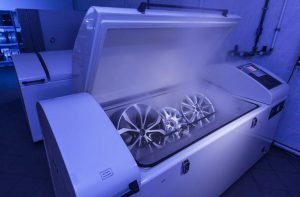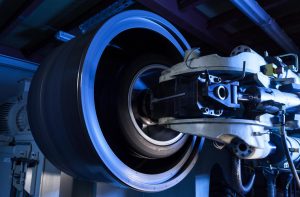Putting Wheels through Their Paces
Alloy wheels from renowned manufacturers are high-quality products that are subjected to comprehensive tests and inspections. Manufacturers who supply wheel rims for premium auto brands must hold themselves to particularly high quality standards. They usually have their own stringent performance test and inspection facilities on site. Once the newest product developments have withstood thorough manufacturer tests, the wheels are inspected once again by an independent institute before being released for production. This external inspection serves as the basis for issuance of the general operating permit (ABE) or an ECE certification.
 In reality, though, quality assurance for alloy wheels begins much earlier with the selection and testing of raw materials. Premium manufacturers like RIAL only use special alloys from trusted suppliers. Every batch of raw aluminum has a barcode that is scanned upon delivery. This makes it possible for the origin to be traced back at any time. Before the manufacturers process the aluminum, they take samples from every batch and examine their chemical composition though spectral analysis.
In reality, though, quality assurance for alloy wheels begins much earlier with the selection and testing of raw materials. Premium manufacturers like RIAL only use special alloys from trusted suppliers. Every batch of raw aluminum has a barcode that is scanned upon delivery. This makes it possible for the origin to be traced back at any time. Before the manufacturers process the aluminum, they take samples from every batch and examine their chemical composition though spectral analysis.
The intense testing continues throughout the manufacturing process. Every wheel must pass an automatic x-ray test directly after being cast. This is followed by constant dimensional accuracy controls, both fully automatic and manual. All wheels undergo precise impact tests. To benefit the coating that will eventually be applied, the wheels undergo automatic degreasing directly after processing. This is followed by helium leak testing, concentricity testing, and a final inspection. This array of procedures allows manufacturers to virtually eliminate the possibility of defective wheels during the production process. 
Premium manufacturers additionally put their products through endurance tests and other inspection methods in special labs. Winter performance, for example, is confirmed through the CASS (Copper Accelerated Salt Spray) test, in which pre-damaged paint is exposed to a brine with additional copper chloride. In fatigue testing, the wheel is subjected to several hundred thousand load changes – to be precise: 250,000 acceleration and braking sequences. ZWARP testing (bi-axial wheel/hub fatigue testing) simulates 300,000 driving kilometers with various road conditions that will – hopefully – not stretch the wheel to its limits. With all tests passed with flying colors, customers can rest assured that they are driving on wheels made to withstand anything they encounter on the road.


